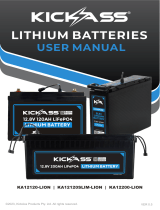
Symbols Used ................................................................................................................................ 1
Introduction .................................................................................................................................. 1
Key Features ..................................................................................................................................1
SKU ..............................................................................................................................................1
What’s In the Box? .......................................................................................................................... 2
Required Tools & Accessories ..........................................................................................................2
Get to Know Deep Cycle Lithium Iron Phosphate Battery ...................................................................3
Dimensions ................................................................................................................................... 3
How to Size Battery Adapter Cables? ................................................................................................4
Fix the Battery to a Position (Optional) ............................................................................................ 4
Step 1. Plan a Mounting Site ............................................................................................................ 5
Step 2. Wear Insulating Gloves ........................................................................................................5
Step 3. Remove the Dust Cover. .......................................................................................................6
Step 4. Check the Battery ................................................................................................................6
Step 5. Run the Battery Adapter Cables Through the Insulating Sleeves .............................................. 6
Step 6. Install Battery Terminals ...................................................................................................... 7
Step 7. Install the Insulating Sleeves ................................................................................................7
Step 8. Connect the Battery to Other Devices .................................................................................... 8
How to Connect Renogy Core Batteries in Series or Parallel ............................................................... 9
Calculate Voltage and Current in Series and Parallel Connections .................................................................9
Balance Batteries Prior to Connection ..............................................................................................................9
Series Connection vs. Parallel Connection — Installation Steps ...................................................................10
Battery Cell Balancing ......................................................................................................................................12
Charging/Discharging Parameter Settings ...................................................................................... 13
Battery Charging and Discharging Logic ......................................................................................... 13
Charging Logic ..................................................................................................................................................13
Discharging Logic .............................................................................................................................................14
How to Estimate the Battery SOC? ................................................................................................. 14
Battery Management System ........................................................................................................ 14
Troubleshooting .......................................................................................................................... 15
Specifications .............................................................................................................................. 16
General .............................................................................................................................................................16
Operation Parameters ......................................................................................................................................16
Table of Contents





















